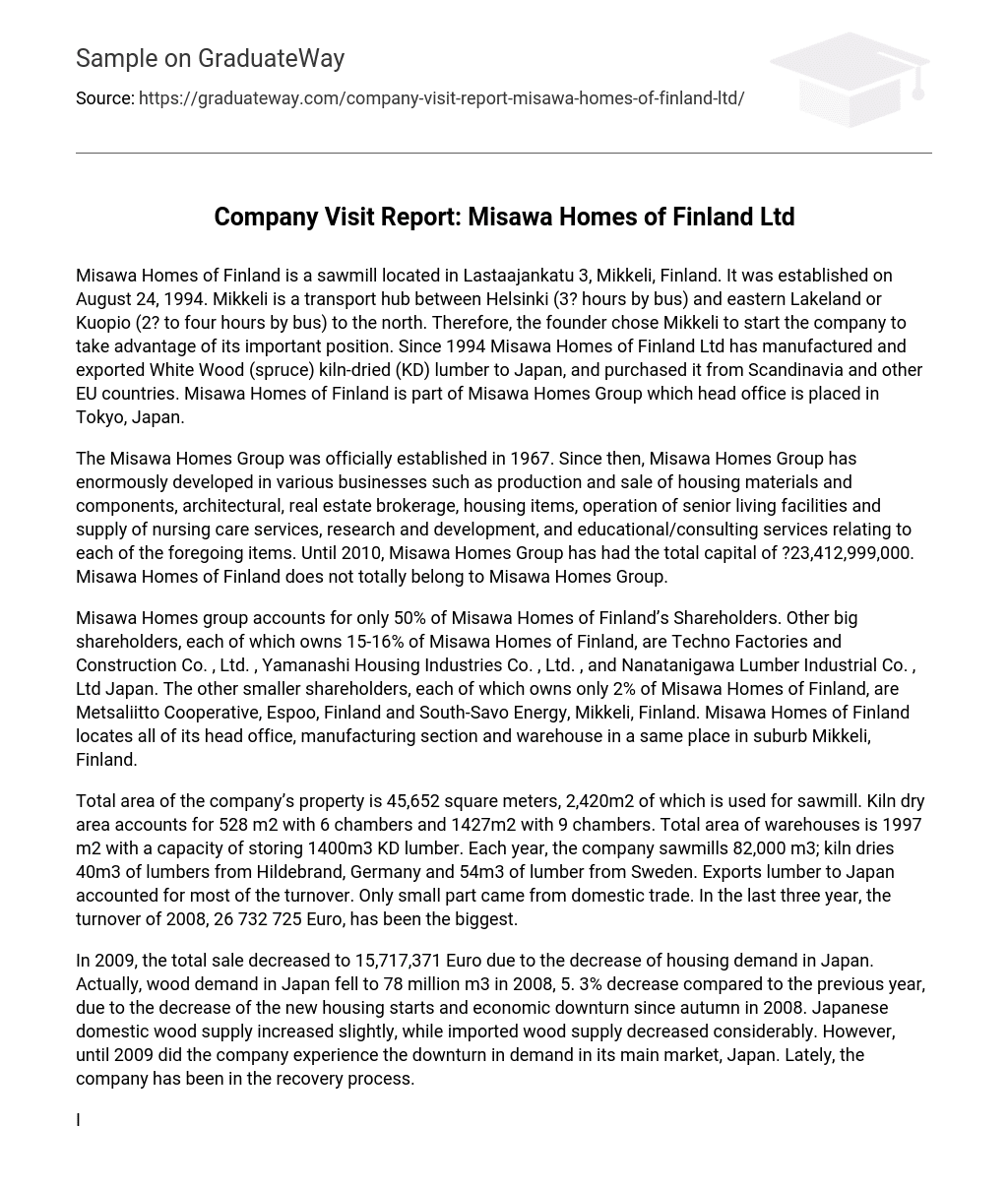Misawa Homes of Finland is a sawmill located in Lastaajankatu 3, Mikkeli, Finland. It was established on August 24, 1994. Mikkeli is a transport hub between Helsinki (3? hours by bus) and eastern Lakeland or Kuopio (2? to four hours by bus) to the north. Therefore, the founder chose Mikkeli to start the company to take advantage of its important position. Since 1994 Misawa Homes of Finland Ltd has manufactured and exported White Wood (spruce) kiln-dried (KD) lumber to Japan, and purchased it from Scandinavia and other EU countries. Misawa Homes of Finland is part of Misawa Homes Group which head office is placed in Tokyo, Japan.
The Misawa Homes Group was officially established in 1967. Since then, Misawa Homes Group has enormously developed in various businesses such as production and sale of housing materials and components, architectural, real estate brokerage, housing items, operation of senior living facilities and supply of nursing care services, research and development, and educational/consulting services relating to each of the foregoing items. Until 2010, Misawa Homes Group has had the total capital of ?23,412,999,000. Misawa Homes of Finland does not totally belong to Misawa Homes Group.
Misawa Homes group accounts for only 50% of Misawa Homes of Finland’s Shareholders. Other big shareholders, each of which owns 15-16% of Misawa Homes of Finland, are Techno Factories and Construction Co. , Ltd. , Yamanashi Housing Industries Co. , Ltd. , and Nanatanigawa Lumber Industrial Co. , Ltd Japan. The other smaller shareholders, each of which owns only 2% of Misawa Homes of Finland, are Metsaliitto Cooperative, Espoo, Finland and South-Savo Energy, Mikkeli, Finland. Misawa Homes of Finland locates all of its head office, manufacturing section and warehouse in a same place in suburb Mikkeli, Finland.
Total area of the company’s property is 45,652 square meters, 2,420m2 of which is used for sawmill. Kiln dry area accounts for 528 m2 with 6 chambers and 1427m2 with 9 chambers. Total area of warehouses is 1997 m2 with a capacity of storing 1400m3 KD lumber. Each year, the company sawmills 82,000 m3; kiln dries 40m3 of lumbers from Hildebrand, Germany and 54m3 of lumber from Sweden. Exports lumber to Japan accounted for most of the turnover. Only small part came from domestic trade. In the last three year, the turnover of 2008, 26 732 725 Euro, has been the biggest.
In 2009, the total sale decreased to 15,717,371 Euro due to the decrease of housing demand in Japan. Actually, wood demand in Japan fell to 78 million m3 in 2008, 5. 3% decrease compared to the previous year, due to the decrease of the new housing starts and economic downturn since autumn in 2008. Japanese domestic wood supply increased slightly, while imported wood supply decreased considerably. However, until 2009 did the company experience the downturn in demand in its main market, Japan. Lately, the company has been in the recovery process.
In 2010, the company announced the turnover of 22,097,687 Euro. Misawa Homes of Finland offers kiln dried lumber, the main product made of white wood (also called Spruce) and some kind of secondary products. After green lumber is first harvested and cut, it is dried in a kiln so that it has low moisture content. When the lumber is completely dried, it usually has moisture content of below 15 percent, making it significantly dryer than green lumber or air dried lumber. The low level of moisture content helps the lumber to avoid warping as it dries and contract.
This kind of lumber is ideal for a wide range of woodworking task, including house building, floor, etc. … The lumber can have different sizes. Normally, the company offers three sizes of width. The length can be fixed or varies a bit depending on customer’s customer’s requirements. The lumber usually has common bright color. In comparison with the same kind of products offered by the other companies, the quality of Misawa’s products is average and a bit above the average. The secondary products created during the process of manufacturing main products are chips, bark and sawdust.
Chips are sold to pulp mill as raw material. Bark and sawdust are sold to an electric power plant. The major market of the lumber is Japan. The demand for lumber used in housing as structural materials is huge. Since 1990s, Japanese has rapidly adopted KD lumber because it meets Japanese precut needs for size accuracy and proper moisture content. Furthermore, the “housing Quality Assurance Law” established in 2000, which required demanding quality of materials in building houses, makes Japan prominent market for kiln-dried lumber.
Besides, after the recent earthquake and tsunami in March, 2011, demand for KD lumber will dramatically increase in the next few years. According to Mr. Yoshiaki (Jeff) Murata, managing director of Misawa Homes of Finland, demand for lumber as well as other structural materials used in the recovery process after the earthquake will not immediately increase. Instead, it will take roughly five years for the recovery process to start and to require more materials.





